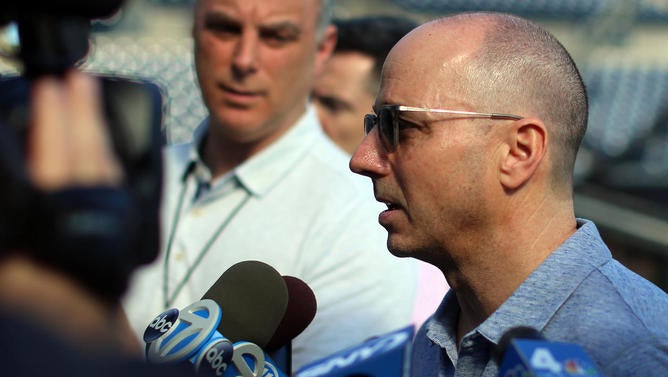By any measure, the Los Angeles Dodgers and New York Yankees are powerhouse teams. The Dodgers have won six straight NL West titles and back-to-back NL pennants. The Yankees went to Game 7 of the ALCS last year and won 100 games this year. Both teams are loaded with young talent too. They are on the very short list of the best teams in baseball.
Both the Dodgers and Yankees experienced their 2018 success -- neither won the World Series, of course, but they had strong seasons -- despite slashing payroll. Baseball's two financial powers were able to stay under the $197 million luxury tax threshold in 2018 to reset their tax rate and reap other financial benefits. The payroll numbers:
| Team | 2017 Payroll | 2018 Payroll | Difference |
|---|---|---|---|
Dodgers | $253.6 million | $194.5 million | $59.1 million |
Yankees | $226.4 million | $192.1 million | $34.3 million |
It should be noted that luxury tax payroll (the figures in the table) differs from actual club payroll. Luxury tax payroll is based on the average annual value of multi-year contracts -- for example, the Dodgers paid Kenley Jansen $11.3 million in actual salary in 2018, but the luxury tax "hit" of his five-year, $80 million contract is $16 million -- and includes other miscellaneous expenses, such as each team's contribution to the player benefits fund.
Point is, the two largest market teams in the game combined to cut more than $90 million -- $90 million! -- off their payrolls in 2018 while being right smack in the middle of their contention windows. And, from the sound of things, staying under the luxury tax threshold was not a one-year plan. Bill Shaikin of the Los Angeles Times reports the Dodgers have told potential investors they plan to stay under the threshold the next four seasons. From Shaikin:
The Dodgers plan to keep their player payroll below the level that would require a luxury tax payment for at least the next four years, according to a document prepared for potential investors and reviewed by The Los Angeles Times.
...
Under the projections prepared for potential investors, the Dodgers would spend $185 million in 2019 and 2020, $191 million in 2021 and $196 million in 2022.
One Dodgers official told Shaikin the numbers sent to investors are a "forecast," and added he would be "shocked" if payroll did not climb over $200 million in 2019. The luxury tax threshold rises to $206 million in 2019, $208 million in 2020, and $210 million in 2021. There are also separate penalty tiers depending how much the team spends over the threshold.
As for the Yankees, general manager Brian Cashman told reporters the GM meetings earlier this week that the team's "preference" is to stay under the luxury tax threshold going forward. "Is it a definite line in the sand? I wouldn't say that's the case. I'd say it's a preference," Cashman said to reporters, including Billy Witz of the New York Times. Here's more from Cashman:
Not a line in a sand, but a preference, Brian Cashman says, for the Yankees to remain under the luxury tax "to not line the pockets of opponents to use that (revenue) against us."
— Arash Madani (@ArashMadani) November 6, 2018
A portion of the money paid into the luxury tax -- prior to 2018, the Yankees paid luxury tax every year since the system was implemented in 2003 -- is redistributed to non-luxury tax paying teams, which is what Cashman is referring to when he says the Yankees don't want to "line the pockets of opponents." Some percentage of every dollar they pay in luxury tax goes to other clubs.
To state the obvious, this could all be posturing. The Dodgers and Yankees could both be gearing up for monster free agent spending sprees -- would there be a better offseason to do that than this one, with Bryce Harper and Manny Machado available? -- and they're simply playing coy. After all, it does them no good to come out and say they're ready to spend big. That hurts their leverage. It's much easier to claim you're not spending big when agents just watched you trim payroll in 2018, you know?

On the other hand, MLB's owners have fought hard to implement the luxury tax system, which now has penalties so severe that it is effectively a salary cap. Repeat offenders who exceed the threshold by at least $40 million are taxed a whopping 92.5 percent. No owner is paying that. The owners wanted this luxury tax system because it saves them money, plain and simple. The less they spend on payroll the larger the portion of the revenues that goes in their pocket.
The MLB Players Association is already upset with the state of the game, specifically with the way free agency played out last offseason. This is all tied together. Free agency was slow in part because the Dodgers and Yankees trimmed payroll, and now that they're at least hinting at staying under the luxury tax threshold next year too, it means less money for the players. Baseball's two biggest spenders trimming payroll is a bad thing for the union.
Only two teams, the Nationals and World Series champion Red Sox, exceeded the luxury tax threshold this season. Boston is expected to remain over the threshold in 2019. It's unclear how Washington will handle their payroll situation. Re-signing Harper would make it all but impossible to get back under the threshold. Given the stiff penalties, it's all but assured team payrolls will not increase drastically in the coming years despite revenues being at an all-time high.






















